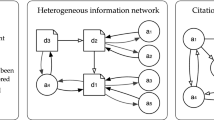Abstract
In this paper, we consider a natural ranking problem that arises in settings in which a community of people (or agents) are engaged in regular interactions with an end goal of creating value. Examples of such scenarios are academic collaboration networks, creative collaborations, and interactions between agents of a service delivery organization. For instance, consider a service delivery organization which essentially resolves a sequence of service requests from its customers by deploying its agents to resolve the requests. Typically, resolving a request requires interaction between multiple agents and results in an outcome (or value). The outcome could be success or failure of problem resolution or an index of customer satisfaction. For this scenario, the ranking of the agents of the network should take into account two aspects: importance of the agents in the network structure that arises as a result of interactions and the value generated by the interactions involving the respective agents. Such a ranking can be used for several purposes such as identifying influential agents of the interaction network, effective and efficient spreading of messages in the network. In this paper, we formally model the above ranking problem and develop a novel algorithm for computing the ranking. The key aspect of our approach is creating special nodes in the interaction network corresponding to the outcomes and endowing them independent, external status. The algorithm then iteratively spreads the external status of the outcomes to the agents based on their interactions and the outcome of those interactions. This results in an eigenvector like formulation, which results in a method requiring computing the inverse of a matrix rather than the eigenvector. We present several theoretical characterizations of our algorithmic approach. We present experimental results on the public domain real-life datasets from the Internet Movie Database and a dataset constructed by retrieving impact and citation ratings for papers listed in the DBLP database.












Similar content being viewed by others
References
Asur S, Parthasarathy S, Ucar D (2007) An event-based framework for characterizing the evolutionary behavior of interaction graphs. In: KDD, pp 913–921
Bonacich P, Lloyd P (2001) Eigenvector-like measures of centrality for asymmetric relations. Soc Netw 23:191–201
Chitrapura KP, Kashyap SR (2004) Node ranking in labeled directed graphs. In: CIKM, pp 597–606
DeLong C, Mane S, Srivastava J (2006) Concept-aware ranking: teaching an old graph new moves. In: ICDM workshops, pp 80–88
Domingos P (2005) Mining social networks for viral marketing. IEEE Intell Syst 20(1):80–82
Haveliwala TH (2002) Topic-sensitive page rank. In: In the proceedings of the world Wide Web (WWW) conference, pp 517–526
Kameshwaran S, Mehta S, Pandit V (2011) Design and analysis of value creation networks. In: Burgard W, Roth D (eds) AAAI. AAAI Press, Menlo Park
Kameshwaran S, Mehta S, Pandit V, Parija G, Singh S, Viswanadham N (2009) Analyses for service interaction networks with applications to service delivery. In: Proceedings of the SIAM international conference on data mining (SDM)
Kameshwaran S, Pandit V, Mehta S, Viswanadham N, Dixit K (2010) Outcome aware ranking in interaction networks. In: Proceedings of the 19th ACM conference on information and knowledge management. CIKM 2010, pp 229–238
Kempe D, Kleinberg J, Tardos E (2003) Maximizing the spread of influence through a social network. In: Proceedings of the ninth ACM SIGKDD international conference on knowledge discovery and data mining. KDD ’03, ACM, New York, NY, USA, pp 137–146
Kendall MG (1955) Further contributions to the theory of paired comparisons. Biometrics 11:43
Kleinberg JM (1999) Authoritative sources in a hyperlinked environment. J ACM 46(5):604–632
Liu X, Bollen J, Nelson ML, de Sompel HV (2005) Co-authorship networks in the digital library research community. Inf Process Manag 41:1462–1480
Newman M (2001a) Scientific collaboration networks: I. Network construction and fundamental results. Phys Rev 64:016131-1–016131-8
Newman M (2001b) Scientific collaboration networks: II. Shortest paths, weighted networks, and centrality. Phys Rev 64:016132-1–016132-7
Page L, Brin S, Motwani R, Winograd T (1998) The pagerank citation ranking: bringing order to the web
Richardson M, Prakash A, Brill E (2006) Beyond PageRank: machine learning for static ranking. In: Proceedings of the 15th international conference on world wide web. WWW ’06, ACM, New York, NY, USA, pp 707–715
Saito K, Kimura M, Ohara K, Motoda H (2012) Efficient discovery of influential nodes for SIS models in social networks. Knowl Inf Syst 30(3):613–635
Sherman J, Morrison WJ (1950) Adjustment of an inverse matrix corresponding to a change in one element of a given matrix. Ann Math Stat 21(1):124–127
Subramani M, Rajagopalachari B (2003) Knowledge-sharing and influence in the online social networks via viral marketing. Commun ACM 46(12):300–308
Tong H, Faloutsos C, Pan J-Y (2008) Random walk with restart: fast solutions and applications. Knowl Inf Syst 14(3):327–346
Wei TH (1952) The algebraic foundations of ranking theory. Cambridge University Press, London
White S, Smyth P (2003) Algorithms for estimating the relative importance in networks. In: Proceedings of the ACM SIGKDD international conference on knowledge discovery and data mining, pp 266–275
Author information
Authors and Affiliations
Corresponding author
Additional information
Preliminary version of this paper appeared in the ACM Conference on Information and Knowledge Management (CIKM), 2010 [9].
Ambika Agarwal and Kashyap Dixit: This work was done while the authors were at IBM Research, India.
Rights and permissions
About this article
Cite this article
Kameshwaran, S., Pandit, V., Mehta, S. et al. Outcome aware ranking in value creation networks. Knowl Inf Syst 38, 537–565 (2014). https://doi.org/10.1007/s10115-012-0598-2
Received:
Revised:
Accepted:
Published:
Issue Date:
DOI: https://doi.org/10.1007/s10115-012-0598-2




